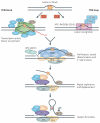Mechanisms of trinucleotide repeat instability during human development
- PMID: 20953213
- PMCID: PMC3175376
- DOI: 10.1038/nrg2828
Mechanisms of trinucleotide repeat instability during human development
Erratum in
- Nat Rev Genet. 2010 Dec;11(12):886
Abstract
Trinucleotide expansion underlies several human diseases. Expansion occurs during multiple stages of human development in different cell types, and is sensitive to the gender of the parent who transmits the repeats. Repair and replication models for expansions have been described, but we do not know whether the pathway involved is the same under all conditions and for all repeat tract lengths, which differ among diseases. Currently, researchers rely on bacteria, yeast and mice to study expansion, but these models differ substantially from humans. We need now to connect the dots among human genetics, pathway biochemistry and the appropriate model systems to understand the mechanism of expansion as it occurs in human disease.
Figures






Similar articles
-
Rearrangements in the flanking sequences of the triplet repeat of the FMR1 gene give clues to the mechanisms involved in repeat instability in fragile X.DNA Repair (Amst). 2008 May 3;7(5):684-5. doi: 10.1016/j.dnarep.2008.01.015. Epub 2008 Mar 11. DNA Repair (Amst). 2008. PMID: 18337192 No abstract available.
-
Replication stalling and heteroduplex formation within CAG/CTG trinucleotide repeats by mismatch repair.DNA Repair (Amst). 2016 Jun;42:94-106. doi: 10.1016/j.dnarep.2016.03.002. Epub 2016 Mar 16. DNA Repair (Amst). 2016. PMID: 27045900
-
DNA mismatch repair in trinucleotide repeat instability.Sci China Life Sci. 2017 Oct;60(10):1087-1092. doi: 10.1007/s11427-017-9186-7. Epub 2017 Oct 24. Sci China Life Sci. 2017. PMID: 29075942 Free PMC article. Review.
-
Tracking Expansions of Stable and Threshold Length Trinucleotide Repeat Tracts In Vivo and In Vitro Using Saccharomyces cerevisiae.Methods Mol Biol. 2020;2056:25-68. doi: 10.1007/978-1-4939-9784-8_3. Methods Mol Biol. 2020. PMID: 31586340
-
Repeat instability as the basis for human diseases and as a potential target for therapy.Nat Rev Mol Cell Biol. 2010 Mar;11(3):165-70. doi: 10.1038/nrm2854. Nat Rev Mol Cell Biol. 2010. PMID: 20177394 Review.
Cited by
-
The Replication of Frataxin Gene Is Assured by Activation of Dormant Origins in the Presence of a GAA-Repeat Expansion.PLoS Genet. 2016 Jul 22;12(7):e1006201. doi: 10.1371/journal.pgen.1006201. eCollection 2016 Jul. PLoS Genet. 2016. PMID: 27447727 Free PMC article.
-
Mature microsatellites: mechanisms underlying dinucleotide microsatellite mutational biases in human cells.G3 (Bethesda). 2013 Mar;3(3):451-63. doi: 10.1534/g3.112.005173. Epub 2013 Mar 1. G3 (Bethesda). 2013. PMID: 23450065 Free PMC article.
-
Flap endonuclease 1.Annu Rev Biochem. 2013;82:119-38. doi: 10.1146/annurev-biochem-072511-122603. Epub 2013 Feb 28. Annu Rev Biochem. 2013. PMID: 23451868 Free PMC article. Review.
-
Friedreich's ataxia-associated GAA repeats induce replication-fork reversal and unusual molecular junctions.Nat Struct Mol Biol. 2013 Apr;20(4):486-94. doi: 10.1038/nsmb.2520. Epub 2013 Mar 3. Nat Struct Mol Biol. 2013. PMID: 23454978
-
LUSTR: a new customizable tool for calling genome-wide germline and somatic short tandem repeat variants.BMC Genomics. 2024 Jan 26;25(1):115. doi: 10.1186/s12864-023-09935-9. BMC Genomics. 2024. PMID: 38279154 Free PMC article.
References
-
- Mirkin SM. Expandable DNA repeats and human disease. Nature. 2007;447:932–940. - PubMed
-
- Kovtun IV, McMurray CT. Features of trinucleotide repeat instability in vivo. Cell Res. 2008;18:198–213. - PubMed
-
-
La Spada AR, Taylor JP. Repeat expansion disease: progress and puzzles in disease pathogenesis. Nature Rev. Genet. 2010;11:247–258. A comprehensive Review of recent progress in understanding the pathophysiology of expansion disease.
-
Publication types
MeSH terms
Grants and funding
LinkOut - more resources
Full Text Sources
Other Literature Sources

